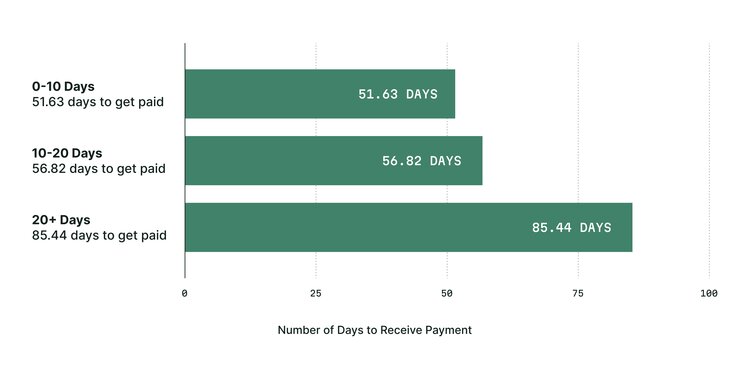Stop chasing payments. Start controlling your cash flow with invoicing built for the trades.

Our research analyzed thousands of invoices sent by commercial contractors across North America and we found a simple truth: the faster you send an invoice for project work, the faster you get paid. When it comes to invoicing, you need to be quick, automated, and error-free.

And you get paid significantly faster, within 50-53 days. This is your ideal invoicing window.
And you’re adding 30+ days to your cash flow cycle. This is the clear inflection point.
And you’ll wait an average of 86 days - more than doubling your time to get paid.
Our contractor invoicing software gets it done, by turning field notes into invoices into payments, instantly.


Our invoicing toolkit for faster contractor invoicing has key strategies that leaders in the field use to speed up their payments.
The toolkit includes a checklist guiding you through every step of the payment cycle, a payment tracker template, a guide on how to use customer segmentation to personalize invoice follow-ups, and more.
On-site and immediate
Providing accurate and fair quotes is the precursor to sending out invoices to your customers. With BuildOps, Quoting is built to work with invoicing, cutting down data entry and invoicing mistakes. Here’s how we do it:

Customers pay faster
After sending invoices, you need to get paid. The easier you make this process on your customers, the more likely they are to pay promptly. With BuildOps Payments+, you can:

Faster invoicing means less waiting, which means more cash in your hands.

With our field service invoicing software, the job is already done. No extra admin, no wasted time, and no mistakes.
Just invoices out, payments in, and customers happy.
Dane Electric saw immediate results when switching to BuildOps, turning their isolated invoicing system with constant mistakes into one with accurate and efficient invoices sent, and enhanced ability to track success.









Contractor invoicing software automates the generation and sending of invoices to your customers. It does this by allowing you to enter all the information about the work done on a job and the prices for services into the software, then generating a summary of the costs.
Service invoice software helps commercial contractors and business owners cut down on time by automating the typically manual process of summarizing all the work and pricing each line item on an invoice.
The software can save prices for parts, labor, and typical services, and can leverage both the information you provided to a customer in a quote, as well as a tech’s field service reports — right into the invoice.
The primary way invoicing software helps any service-based business, construction businesses, and trades-based businesses is by automating the entire payments cycle in one place, so previously manual work is condensed into one efficient process. With each invoice sent out, the time saved adds up day after day, until exponential time savings are realized each month.
With the saved time, businesses can either increase their profits by maintaining a leaner staff because the manual admin work of invoicing is cut down, or you can scale faster by having your staff handle more customers and projects with the time saved by automating this process.
An all-in-one commercial invoicing platform like BuildOps offers a lot of benefits, including:
The main reason that always stands out with our customers is that the BuildOps platform is built specifically for commercial contractors, which means we really excel if your bread and butter is large-scale projects with commercial customers. We constantly connect with our commercial contractors to ask them what features they need and want to see in the platform, and we continue to build tools for them.
One of the standout features of our invoicing tool that our commercial contractors love is the ability to send photos and videos along with your Quotes and Invoices. We’ve found that customers approve Quotes 3x faster with a photo or video than a traditional paper quote. Your customers really appreciate the visual component, which means you get approved and paid faster.
Every company is different and has different Quoting, Invoicing, and Payments needs, so our integration team will spend time with you learning how your payments cycle runs, and then collaborate with your team to integrate the software into your existing accounting and billing process.
You will have a dedicated specialist to help you transition from your current system to ours to make sure its running smoothly before the first invoice is even sent out.
BuildOps integrates with many of the top accounting solutions including QuickBooks, Sage, Vista, Spectrum, and more.
Our commercial field service contractors have increased their profits by 250%, and have done it by slashing billing time by 73% with our service invoice software.
Want to find out exactly how we can do that for you?